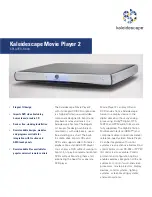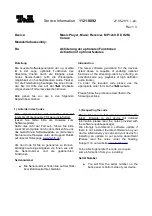Lexicon
56
Errors (CUE) and Interlaced Chroma Problem (ICP). CUE
is caused by improper decoding and de-interlacing of
MPEG encoded video. The Lexicon BD-30 is free of the
CUE problem. ICP is caused by the encoding process for
interlaced video, so you may encounter it on some DVD
and Blu-ray Discs. The CUE-Correction function can detect
and filter out the errors. The available options are:
•
Auto (Recommended)
– Automatic chroma error
detection and correction. Use this setting when you
are not sure if the disc has chroma errors.
•
On
– Chroma filtering is always on. Use this setting if
the disc is known to have chroma errors.
•
Off
– No chroma filtering is applied. Use this setting if
the disc does not have chroma errors.
•
Color Space
– To select the color space for the HDMI
output. The available options are:
•
Auto (Recommended)
– The player checks with the
display device to automatically determine what color
space to use. If the display device supports YCbCr
4:4:4, then it will be used to avoid extra color space
conversion.
•
RGB Video Level
– The HDMI output uses RGB color
space and normal signal range suitable for video
displays.
•
RGB PC Level
– The HDMI output uses RGB color
space and expands the signal range. The expanded
signal range is suitable for personal computer (PC)
displays. Some TVs are designed to be used as a PC
monitor, and expect signal in expanded RGB range
when the DVI input is selected. For these displays if
the video signal uses the normal RGB range, the
black-white contrast will be reduced. You can set the
player to use the RGB PC Level output and restore
proper contrast.
•
YCbCr 4:4:4
– The HDMI output uses YCbCr 4:4:4
color space.
•
YCbCr 4:2:2
– The HDMI output uses YCbCr 4:2:2
color space. Generally this is the color space that is
closest to the color space encoded on the discs. (All
discs are encoded in YCbCr 4:2:0 color space, and the
video decoder decodes it into YCbCr 4:2:2.)
•
HDMI Deep Color
– Deep Color is an OPTION for some
TVs or projectors that feature HDMI v1.3 inputs. Normally,
each pixel of the video image is transmitted using 24-bit
data (8-bit per channel for R, G, B or Y, Cb, Cr). If Deep
Color is supported, each pixel of the video image can be
transmitted using 30-bit (10-bit per channel) or 36-bit
(12-bit per channel) data. The increased bit depth should
result in smoother color transitions and better gradients.
The available options are:
•
30 Bits
– Use the 30-bit per pixel Deep Color mode.
•
36 Bits
– Use the 36-bit per pixel Deep Color mode.
•
Off
– Do not use Deep Color.
Note
Since the Deep Color feature is OPTIONAL and may not be supported
by all TVs, enabling Deep Color while connected to a TV without this
feature may result in no effect or no video.
At this time, no disc is encoded with Deep Color. Enabling Deep
Color will not magically make colors richer, but will help preserve the
maximum precision as a result of video processing and picture control
adjustment.
•
Demo Mode
– To enable a special split-screen
demonstration mode. This is designed for the
demonstration of VRS
™
video processing technology.
It can also be used as an aid for setting picture control
adjustments for Detail Enhancement, Edge Enhancement
and Noise Reduction. It should NOT be used for normal
movie watching. The available options are:
Setup Menu Options
Summary of Contents for BD-30
Page 1: ...BD 30 Blu ray Disc Player User Guide ...
Page 2: ......
Page 10: ......
Page 52: ......
Page 76: ......
Page 77: ...References 7 Useful Notes 74 Troubleshooting 74 Specifications 76 Language Code List 77 ...
Page 89: ...BD 30 Blu ray Disc Player 85 Appendix ...
Page 90: ...Lexicon 86 Appendix ...
Page 91: ...BD 30 Blu ray Disc Player 87 Appendix ...
Page 92: ...1718 W Mishawaka Rd Elkhart IN 46517 USA Tel 516 594 0300 www lexicon com XXXXXXX VX X ...


















